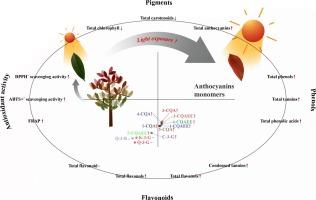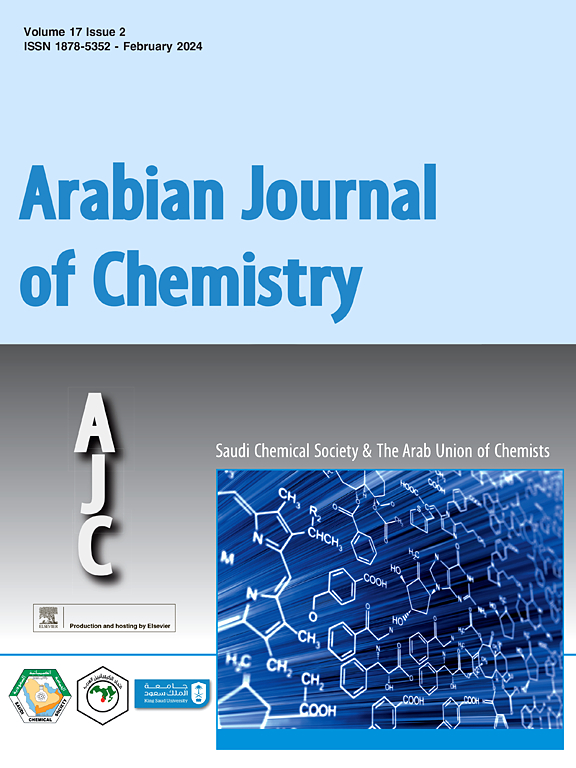光照强度在调节 Photinia × fraseri 叶片颜色、花青素和多酚含量以及抗氧化活性方面起着关键作用
IF 5.3
2区 化学
Q2 CHEMISTRY, MULTIDISCIPLINARY
引用次数: 0
摘要
光照叶(Photinia × fraseri)是中国广泛栽培的重要观赏植物品种,叶色鲜艳。然而,关于不同颜色的光照叶片(PFL)中酚类成分和生物活性的差异,以及决定其颜色形成的关键因素的信息十分有限。因此,本研究旨在建立不同光照强度下 PFL 的叶片颜色、花青素和多酚含量以及抗氧化活性之间的相关性。对四组 PFL 的颜色和色素分析结果表明,总花青素含量与红色的形成呈正相关。同时,红叶的总花青素(0.66 ± 0.02 mg/g)、酚类(24.86 ± 1.33 mg/g)、单宁(6.98 ± 0.23 mg/g)、酚酸(73.60 ± 3.56 mg/g)、缩合单宁(131.24 ± 5.51 mg/g)、黄烷醇(3.42 ± 0.03 mg/g)、黄酮醇(57.58 ± 0.19 mg/g)和抗氧化活性(DPPH 为 0.17 ± 0.00 mmol/g,ABTS 为 0.99 ± 0.06 mmol/g,FRAP 为 1.73 ± 0.03 mmol/g)。此外,还从红叶中鉴定出 11 种酚类化合物,而咖啡酰奎宁酸衍生物和青花素-3-O-葡萄糖苷是红叶中富含的主要酚类化合物。主成分分析、层次聚类分析和相关分析表明,高光照强度是红叶颜色形成的关键因素,红叶中的花青素、酚酸和黄烷醇总量高,抗氧化活性强。总之,本研究有助于发掘重要园艺植物 P. fraseri 的药用潜力,并为其进一步的产业开发和应用提供理论指导。本文章由计算机程序翻译,如有差异,请以英文原文为准。

Light intensity plays the key role in the regulation of leaf color, anthocyanin and polyphenol profiles, as well as antioxidant activity of Photinia × fraseri leaves
Photinia × fraseri is an important ornamental plant species widely cultivated in China with vibrant leaf color. However, there is limited information about the difference of phenolic constituents and bioactivity among P. fraseri leaves (PFL) with varied color, and the key factor which determines its color formation. Therefore, the aim of the present study was devoted to establishing the correlation among leaf color, anthocyanins and polyphenols profiles, together with antioxidant activity of PFL under varied light intensity. Results of color and pigment analysis on the four PFL groups indicated that total anthocyanins content was positively correlated with red color formation. Meanwhile, red leaves further exhibited a higher level of total anthocyanins (0.66 ± 0.02 mg/g), phenols (24.86 ± 1.33 mg/g), tannins (6.98 ± 0.23 mg/g), phenolic acids (73.60 ± 3.56 mg/g), condensed tannins (131.24 ± 5.51 mg/g), flavanols (3.42 ± 0.03 mg/g), flavonols (57.58 ± 0.19 mg/g), and antioxidant activities (0.17 ± 0.00 mmol/g for DPPH, 0.99 ± 0.06 mmol/g for ABTS, 1.73 ± 0.03 mmol/g for FRAP). Furthermore, a total of 11 phenolic compounds were identified from PFL, while caffeoylquinic acid derivatives and cyanidin-3-O-glucoside were the key phenolic compounds rich in red leaves. Principal component, hierarchical cluster, and correlation analysis indicated that high light intensity was the key factor responsible for the red color formation, as well as the high levels of total anthocyanins, phenolic acids and flavanols and antioxidant activities in the red leaves. Overall, the present study shall contribute to the exploration of the medicinal potential of the important horticultural plant P. fraseri and provide theoretical guidance for its further industrial development and application.
求助全文
通过发布文献求助,成功后即可免费获取论文全文。
去求助
来源期刊

Arabian Journal of Chemistry
CHEMISTRY, MULTIDISCIPLINARY-
CiteScore
10.80
自引率
3.30%
发文量
763
审稿时长
63 days
期刊介绍:
The Arabian Journal of Chemistry is an English language, peer-reviewed scholarly publication in the area of chemistry. The Arabian Journal of Chemistry publishes original papers, reviews and short reports on, but not limited to: inorganic, physical, organic, analytical and biochemistry.
The Arabian Journal of Chemistry is issued by the Arab Union of Chemists and is published by King Saud University together with the Saudi Chemical Society in collaboration with Elsevier and is edited by an international group of eminent researchers.
 求助内容:
求助内容: 应助结果提醒方式:
应助结果提醒方式:


